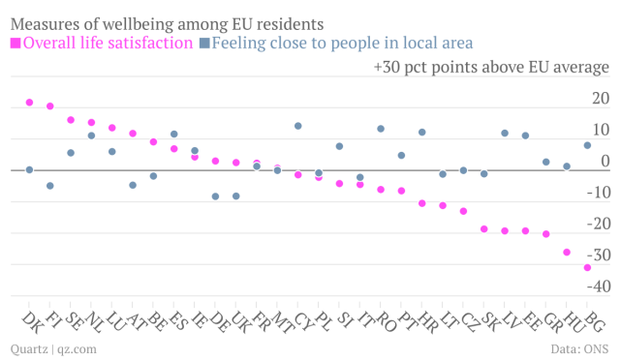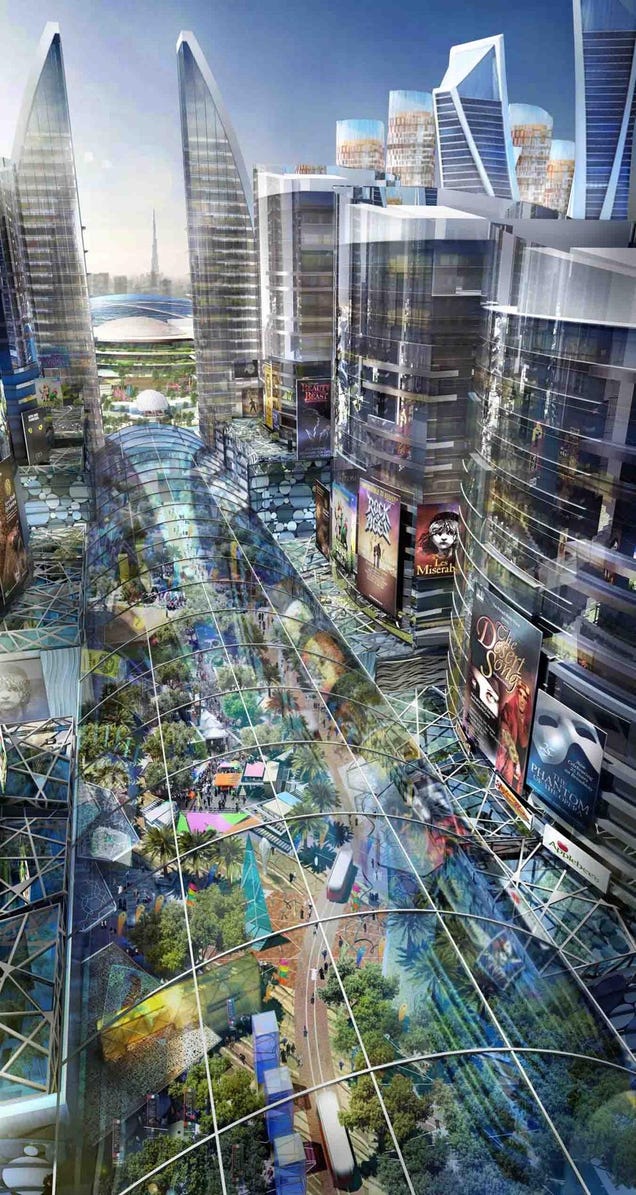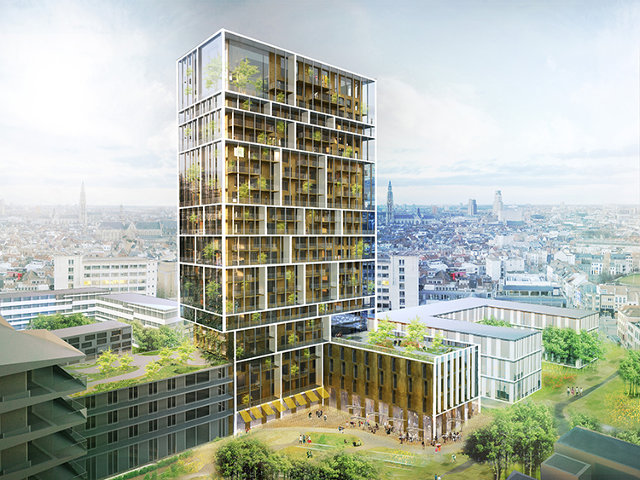Who'da thunk it? Although this isn't the first time I discovered that a favorite childhood cartoon was actually an allegory or a story with a much deeper meaning.
One of the themes in the film pertains to the dismantling of public transportation systems by private companies who would profit from an automobile transportation system and freeway infrastructure. Near the end of the film, Judge Doom reveals his plot to destroy Toon Town to make way for the new freeway system. This is an indirect historical reference to the dismantling of public transportation trolley lines by National City Lines during the 1930s in what is also known as the Great American streetcar scandal. The name of Doom's company, Cloverleaf Industries, is a reference to a common freeway-ramp configuration—an image of which was prominently displayed in the opening credit sequence of The Wonderful World of Disney.
Thursday, 28 August 2014
Wednesday, 27 August 2014
Inside Johannesburg’s Infamous Ponte City Tower
The history of Johannesburg‘s Ponte City Apartments is a provocative one: built in 1975 and designed by Manfred Hermer as the height of luxurious (white-only) living in South Africa, the continent’s tallest residential building soon became a notorious vertical slum, filled with crime and poverty, its signature hollow core re-purposed as a trash dump and a suicide drop.
Since 2001, however, the building has been the centerpiece of a drive to regenerate the wider Hillbrow neighborhood. The building is gentrifying once again – an almost color-coded gentrification as white people move back into the tower, mostly taking the more expensive upper apartments. However, as the video by Vocative shows, in the case of Ponte, gentrification is not as simple as elsewhere: heavy security eases the fears of middle class residents in what is still one of the most dangerous neighborhoods in Johannesburg.
What Gentrification Really Is and How We Can Avoid It
Gentrification is seen as a rising menace in many cities. The process whereby rich “gentrifiers” move into neighborhoods, driving up property prices and thus driving out those unable to afford those prices, has drawn criticism from activists and planners for years. However, this article by io9 writer Annalee Newitz, first published by io9 as “This is What Gentrification Really Is“, tells us that the issue is not quite the struggle between good and evil that it first appears to be. Gentrification is a process dependent on economy, political climate, and the mercurial nature of urban development itself – and sometimes fighting against it only serves to exacerbate the problem. Find out what we can do in the face of gentrification after the break.
 |
| Photo via Affordable Housing Institute |
In many cities, it’s become popular to hate “gentrifiers,” rich people who move in and drive up housing prices — pushing everyone else out. But what’s going on in these rapidly-changing urban spaces is a lot more complicated than that.
Tuesday, 26 August 2014
The Top Ten Best Busking Hotspots in the World
Buskers are street performers that entertain a transient audience. As such, they create art that reflects the cultural, social and economic state of their audience in order to engage them in a short period of time. The result is that their music, dance, theatre and comedy has a different flavour in each city. Comparing how the buskers connect to their audiences in each location gives you more information about current local culture there than, say, the museums, restaurants, shops or bars, as a busker’s audience is much more diverse. Buskers are a real mirror of their surroundings, projected in a way designed to move you.
What follows is a top ten list of the best busker cities pitches in the world, based on nothing more than my own experiences. The buskers in each pitch have obviously affected my choices, so this is far from an academic list.
Wednesday, 20 August 2014
In Europe, knowing your neighbour doesn't necessarily make you happy
For Jean-Paul Sartre, hell was other people. Many in Europe seem to share the French philosopher’s view.
The UK’s Office for National Statistics recently published the results of a pan-European survey on happiness. Thousands of Europeans were asked a range of questions about their relationships, work, health, finances, and much else besides.
As is usually the case, in terms of overall life satisfaction, Scandinavians top the list, while Eastern Europeans are the gloomiest. But things get more interesting when you dig into the details:
The UK’s Office for National Statistics recently published the results of a pan-European survey on happiness. Thousands of Europeans were asked a range of questions about their relationships, work, health, finances, and much else besides.
As is usually the case, in terms of overall life satisfaction, Scandinavians top the list, while Eastern Europeans are the gloomiest. But things get more interesting when you dig into the details:
Tuesday, 19 August 2014
Why commute times don't change much even as a city grows
For as much as U.S. metros have grown over the past few decades, commute times have remained oddly stable. One-way commutes averaged 21.7 minutes in 1980 and 25.3 minutes in 2010. That's not nothing — it's 30 hours more a year assuming 250 work days — but it's also not nearly as much as decade upon decade of urban sprawl might suggest. As bad as our daily commutes are, in many ways we're fortunate they aren't worse.
So why aren't they worse? Among the most compelling ideas to explain this phenomenon is that people have daily "travel time budgets" of about an hour that they refuse to exceed. (This budget is often called "Marchetti's Constant,"though it's better attributed to Yacov Zahavi.) But that alone isn't enough to explain what's happening. After all, if traffic increases and jobs stay in the same place, then our hour won't get us as far as it once did, whether we like it or not.
Then what else is going on? Two new papers target this classic question in a fresh way. Their findings suggest that much of what's going on is more people relying on public transit.

So why aren't they worse? Among the most compelling ideas to explain this phenomenon is that people have daily "travel time budgets" of about an hour that they refuse to exceed. (This budget is often called "Marchetti's Constant,"though it's better attributed to Yacov Zahavi.) But that alone isn't enough to explain what's happening. After all, if traffic increases and jobs stay in the same place, then our hour won't get us as far as it once did, whether we like it or not.
Then what else is going on? Two new papers target this classic question in a fresh way. Their findings suggest that much of what's going on is more people relying on public transit.

Monday, 18 August 2014
Dubai Unveils Plans For A 48-Million-Square-Foot Pedestrian City
An Apartment Tower Designed To Help Residents Make Friends
A 24-STORY RESIDENTIAL DEVELOPMENT IN BELGIUM IS DESIGNED TO GET PEOPLE TALKING.
It's hard to foster community in a tower. This is a realisation many companies are coming to about their high-rise headquarters, but the notion applies equally to high-rise housing. High-rise towers often lack common spaces that give people a reason to bump into each other or hang out informally. There's only so much interaction that can happen as people move straight from the lobby to an elevator, then into their apartment.
Social interaction is the main goal of a new mixed-use high-rise design in Antwerp, Belgium, by C.F. Møller Architects and Brut Architecture and Urban Design.
It's hard to foster community in a tower. This is a realisation many companies are coming to about their high-rise headquarters, but the notion applies equally to high-rise housing. High-rise towers often lack common spaces that give people a reason to bump into each other or hang out informally. There's only so much interaction that can happen as people move straight from the lobby to an elevator, then into their apartment.
Social interaction is the main goal of a new mixed-use high-rise design in Antwerp, Belgium, by C.F. Møller Architects and Brut Architecture and Urban Design.
Friday, 15 August 2014
House of Vans Opens a Subterranean Skatepark Beneath the Streets of London
U.S. clothing and footwear brand House of Vans has transformed a series of five disused tunnels beneath the streets of London into an indoor skate park! The Old Vic Tunnels at London’s Waterloo were recently transformed into a subterranean cultural and entertainment hub with pop-ups and performances, but it was closed last year until the footwear giant gave it a major makeover. Now revived, the underground playground comes with a gallery, cinema, café and artist studios.
SCADpads: A Parking Garage Transformed into a Mirco Village
The Savannah College of Art and Design (SCAD) recently transformed the top covered-floor of a parking garage in Midtown Atlanta, into three 12.5 square metre mircohomes or SCADPads as they are calling them.

Thursday, 14 August 2014
Can Subiaco cope with the loss of the Subiaco markets? Can I cope?
Non-investigative reporter Noah McDonald goes deep under cover to uncover the shocking truth!
The iconic Subiaco markets site is seemingly destined for redevelopment with reports a proposal for a four-storey complex that will include 4,850 square metres of office space is due to be lodged with the Metropolitan Redevelopment Authority in the near future. Now of course re-development is the property owners right, and of course such a proposal is entirely sensible for an owner seeking to realise the development potential of a property within a redevelopment area, BUT, what about me and my needs?!
The iconic Subiaco markets site is seemingly destined for redevelopment with reports a proposal for a four-storey complex that will include 4,850 square metres of office space is due to be lodged with the Metropolitan Redevelopment Authority in the near future. Now of course re-development is the property owners right, and of course such a proposal is entirely sensible for an owner seeking to realise the development potential of a property within a redevelopment area, BUT, what about me and my needs?!
Subscribe to:
Posts (Atom)







